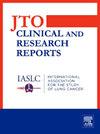在少进展、egfr突变的非小细胞肺癌中,局部消融治疗后再注射奥西替尼:一项2期研究
IF 3.5
Q2 ONCOLOGY
引用次数: 0
摘要
奥西替尼在晚期egfr突变的NSCLC中显示出令人印象深刻的疗效;然而,阻力是不可避免的。我们假设对于少进展性疾病(最多5个部位)的局部消融治疗(LAT),随后再用奥西替尼治疗,将是安全的,并提供额外的第二次无进展生存期(PFS2)获益。该前瞻性2期试验纳入了egfr突变的NSCLC患者,分为三个队列:酪氨酸激酶抑制剂(TKI)初治(队列1),先前接受过TKI治疗并发生获得性T790M耐药突变(队列2),或先前接受过奥西替尼治疗并发生耐药(队列3)。第1组和第2组的患者首先接受奥西替尼治疗,然后在进展缓慢时接受LAT治疗,然后再接受奥西替尼治疗。队列3患者在入组时接受LAT,随后接受奥西替尼再挑战。主要终点是所有三个队列中接受LAT的患者的安全性、耐受性和PFS2。次要终点为PFS1和总有效率。结果共纳入37例egfr突变的NSCLC患者;1组25人,2组9人,3组3人。在所有三个队列中,共有21例患者接受了LAT治疗,该人群的中位PFS2为3.7个月(95%置信区间:1.9-4.6个月)。发现了一个具有异常长PFS2的亚组,在接受LAT之前使用奥西替尼实现了较低的肿瘤负荷和循环肿瘤dna阴性的EGFR克隆的最小残留病。与LAT相关的大多数不良事件为1级和2级。结论:这是首个探索局部治疗和奥西替尼再挑战对奥西替尼寡进展的前瞻性试验。中期分析显示,与LAT后继续使用第一代EGFR TKIs的历史数据相比,意向治疗患者的PFS2未达到其主要目标。然而,在使用循环肿瘤dna阴性最小残留疾病状态作为预测谁将从LAT后继续使用奥西替尼获益的生物标志物的患者中,可以仔细考虑明确的LAT。本文章由计算机程序翻译,如有差异,请以英文原文为准。
Local Ablative Therapy Followed by Osimertinib Rechallenge in Oligoprogressive, EGFR-Mutated NSCLC: A Phase 2 Study
Introduction
Osimertinib has exhibited impressive efficacy in advanced EGFR-mutated NSCLC; however, resistance is inevitable. We hypothesized that local ablative therapy (LAT) for oligoprogressive disease (up to five sites), followed by osimertinib rechallenge, would be safe and provide additional second progression-free survival (PFS2) benefit.
Methods
This prospective phase 2 trial enrolled EGFR-mutated NSCLC patients in three cohorts: tyrosine kinase inhibitor (TKI)–naive (cohort 1), previously treated with TKI and developed acquired T790M resistance mutation (cohort 2), or previously treated with osimertinib and developed resistance (cohort 3). Patients in cohorts 1 and 2 received upfront osimertinib followed by LAT on oligoprogression, followed by osimertinib rechallenge. Cohort 3 patients underwent LAT on enrollment, followed by osimertinib rechallenge. The primary end points were safety, tolerability, and PFS2 among the patients who underwent LAT across all three cohorts combined. Secondary end points were PFS1 and overall response rates.
Results
A total of 37 patients with EGFR-mutated NSCLC were enrolled; 25 in cohort 1, nine in cohort 2, and three in cohort 3. A total of 21 patients received LAT across all three cohorts combined, yielding a median PFS2 of 3.7 months (95% confidence interval: 1.9–4.6 mo) for this population. A subgroup with exceptionally long PFS2 was identified that achieved lower tumor burden and circulating tumor DNA–negative minimal residual disease of the EGFR clone with osimertinib before undergoing LAT. Most adverse events related to LAT were grades 1 and 2.
Conclusions
This is the first prospective trial exploring local therapy and osimertinib rechallenge on oligoprogression on osimertinib. Interim analysis revealed that PFS2 in the intention-to-treat patients did not meet its primary goal when compared with historical data on continuation of first-generation EGFR TKIs after LAT. However, definite LAT can be carefully considered in patients using circulating tumor DNA–negative minimal residual disease status as a biomarker for predicting who will benefit from continuation of osimertinib post-LAT.
求助全文
通过发布文献求助,成功后即可免费获取论文全文。
去求助
来源期刊

JTO Clinical and Research Reports
Medicine-Oncology
CiteScore
4.20
自引率
0.00%
发文量
145
审稿时长
19 weeks
 求助内容:
求助内容: 应助结果提醒方式:
应助结果提醒方式:


